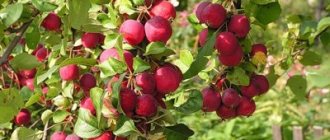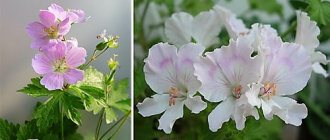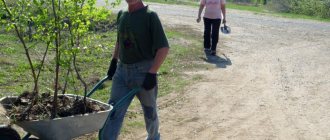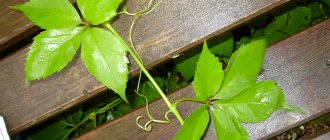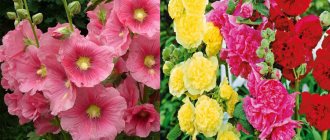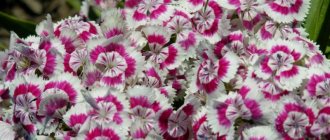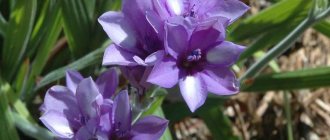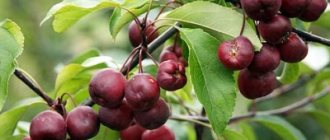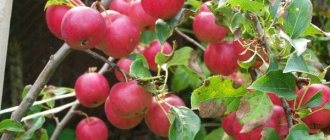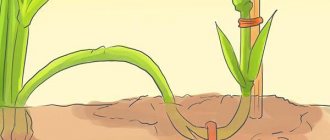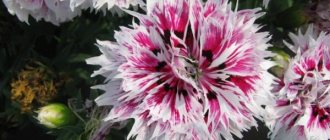The Chinese Kerr apple tree, the description, properties and cultivation of which this article is devoted to, was brought from Canada to Russia only a few decades ago. She was bred by crossing two high-quality Chinese females - Dolgo and Kharalson. Thanks to this combination, this apple tree is resistant not only to a number of diseases, but also tolerates drought and frost well, and also bears fruit abundantly already in the fourth year after planting. This variety is considered autumn-winter. It is regionalized in both the West Siberian and Ural regions, but it can also be successfully grown in the Moscow region.
Description of Chinese Kerr
The tree itself is not tall, with a slightly dense crown. Its smooth, elliptical leaves with slightly jagged edges and pointed upwards are light green. The flowers on the apple tree are quite large, bright pink and very fragrant, which attracts a large number of pollinating insects. During the flowering period, China Kerr is a wonderful decoration for the garden.
The fruits on this apple tree ripen late - only by mid-September, and the timing depends on the region of planting. They have a slightly elongated shape and a rich burgundy skin. The apples weigh about 35-40 g. They taste sweet with sourness and a unique tartness unique to this variety. The fruits are rich in vitamins C and the rather rare P, which helps strengthen the walls of blood vessels. Kerr apples can be used for making compotes and jam. Plus, they can even be frozen.
Variety varieties
The advantages of the Chinese woman prompted breeders to develop varieties that would differ in their external and taste qualities. This is how the varieties Kitayka Belfleur, Zheltaya, Long, Kerr and others appeared:
| Varieties | Description | Advantages | Flaws |
| Golden | The result of crossing White filling and Chinese. The tree grows medium-sized in the shape of a pyramid, with slightly drooping branches. The fruits weigh 40-60 g and have a bright yellow color. |
|
|
| Kerr | Obtained by crossing two varieties of Kitayok - Dolgo and Kharalson. The tree is small in size, with a round and compact crown. The fruits grow weighing 35-45 g. |
| Late harvest (apples ripen by mid-September). |
| Bellefleur | A hybrid of Bellefleur yellow and Chinese large-fruited varieties. The tree grows tall, with a dense crown. The fruits grow weighing from 120 to 300 g. |
|
|
| Red | The tree grows small in height, the crown is columnar in shape |
|
|
| For a long time | The trees are low-growing (no higher than 4 m), the branches grow to the sides, which can make the tree look like a bush. The crown is thick and requires shaping. The fruits grow very small - 15-20 g. |
|
|
| Yellow | Obtained by crossing the Bellefleur yellow variety with Kitayka. The fruits grow weighing up to 40 g. |
|
|
| Pink | Tall trees (up to 10 m) with a ball-shaped crown. The fruits grow small, weighing up to 40 g. |
|
|
| Saninskaya | Tall trees with a dense crown. Sweet and sour fruits grow weighing up to 35 g. |
|
|
| Cream | Bred from seedlings of the varietal Chinese Apricot. The tree grows tall (up to 9 m), with a pyramid-shaped crown. The fruits grow weighing 60-80 g. |
|
|
| Honey | The trees grow tall, the crown is round in shape. The fruits are small, weighing up to 40 g. |
|
|
We invite you to watch a video about the variety of Kitayka - the Kerr variety:
Selecting a location
Usually, for planting apple trees, Chinese Kerrs give preference to elevated areas, since the growth of this fruit crop in gardens with extremely high groundwater levels greatly slows down its growth. Sometimes it happens that a suitable place for planting such trees simply cannot be found. If the groundwater lies too close to the surface, then additional drainage will be necessary. To do this, drainage channels are installed near the apple trees.
It is believed that China Kerr is an unpretentious tree in terms of soil quality, but it is best planted on light sandy soil. When choosing a site, you should also pay attention to the fact that apple trees of this variety, compared to others, have an insufficiently strong root system. This is why trees must be protected from the wind.
Landing
Work begins by digging a hole for each tree, at least 80 cm deep and about 1 m wide. Special soil is poured into the resulting hole, consisting of two parts of sand (preferably river), three of humus and one of deciduous soil. In addition, it is necessary to add mineral fertilizers: 100 g of potassium sulfate and 250 g of wood ash and superphosphate.
Trees can be planted either in the spring, before buds open, or from mid-autumn. The distance between the holes should be at least 6 m. When planted correctly in the fall, young seedlings begin to grow quickly and by spring they produce their first shoots. At this time, the ends of each branch are trimmed and thereby form the crown of the Chinese Kerr.
Reproduction and planting
The plant propagates by grafting or seeds. To increase germination, it is recommended to stratify the seeds.
The Chinese apple tree, or rather apple tree seedlings two to three years old, takes root quickly and without any problems. Recommended planting time is late September–early October. The best place is well-lit and with low groundwater. Light shade is possible at the planting site.
Apple tree seedlings take root quickly
The agricultural technology for planting seedlings is similar to the agricultural technology for planting other fruit crops. Depending on the size of the roots of the seedling, they dig a hole up to 90 cm deep. The holes are dug at a distance of 6-7 meters from each other. Add the mixture to the bottom in the following proportion:
- three parts of humus;
- two parts sand;
- one part from a mixture of leftover leaves, small branches and everything that is found in the compost heap in the garden plot.
Ash from the stove or fireplace is also added there, plus superphosphate and potassium sulfate, 220 and 100 g each, respectively. All components are mixed. A peg is driven in the middle of the hole so that its upper part is above the ground at a height of up to half a meter. A seedling will be tied to it.
Important! Before planting, you need to soak the root of the apple tree in water for several hours. And just before planting, dip the root in a brown slurry made from a mixture of water and soil.
The roots are trimmed down to living wood using pruning shears. All leaves on the tree are removed. The seedling is planted so that the root collar is above the ground at a distance of 5 cm. Otherwise, when the root collar is recessed into the soil, the growth of the apple tree will be slowed down, and fruiting will not be regular in the future. The seedling is evenly covered with earth, tied to a stick with twine so that there is “free movement” with possible slight fluctuations from the wind. The landing site is carefully compacted to avoid voids in the pit.
The seedling must be tied to a peg for the first two to three years. The planting site is spilled with three buckets of water and mulched to a width of up to 5 cm. A mixture of sawdust and remnants of grass or leaves is used as mulch.
Before the onset of cold weather, it is important to monitor the soil moisture and, if necessary, water the tree again. With the onset of cold weather, the mulch layer is increased to 20 cm
To protect the seedling from a long winter, it is recommended to build a protective frame in the form of a cone and wrap it with film. In early spring, the frame must be removed so that the seedling does not ripen. The seedling is protected from rodents using spruce branches placed near the root. And from moles - by installing traps or “fans”. If the planting procedure was successful, then during the fall the seedling should take root and begin to grow with the onset of spring.
Caring for apple trees in the first year of planting
Do not forget that the roots of these trees are shallow, so at first the seedlings need to be tied to wooden pegs. During this period, it is very important to know that a young apple tree should not be allowed to produce fruit. To prevent this from happening, it is necessary to cut off all the flowers on the tree. Such actions will contribute to good seedling growth and a bountiful harvest in the future.
In their first spring, it will be useful to treat trees with copper sulfate twice: once during the period of swelling of deciduous (vegetative) buds, and the second time during the maturation of flower (generative) buds. During the summer months, young Chinese Kerr apple trees (photo above) also need care. From time to time it is necessary to check them for the presence of pests such as weevils, caterpillars and aphids, and to pick off already diseased or damaged foliage. In addition, a tree trunk circle with a diameter of 1 m must be completely free of weeds, since they take away all the beneficial substances contained in the soil. At the same time, the use of herbicides is strictly prohibited - they cause irreparable harm to the seedlings.
Harvest and storage
The fruits are collected at once before frost
The optimal time for harvesting is September. The apples are picked at the same time. You can’t leave them on the branches until frost. If the fruits freeze, they will lose their quality characteristics. The apples are collected directly into wooden boxes.
The harvest is stored in special conditions. The room temperature should be no more than 1 °C. The average shelf life of the crop is 2-3 months. It is better not to keep fruits of different types together.
Fruits are distinguished by good transportability: they do not lose their attractive appearance.
Seasonal care
In order to get abundant harvests every year, you need to know how to properly care for Chinese Kerr apple trees (a photo of planting a tree can be seen in the article). In March, when the snow begins to melt, it is necessary to carefully inspect each trunk. If any damage appears on it, it should be immediately treated with garden varnish. Sometimes in the spring it is discovered that the trunk is badly chewed. In this case, you should vaccinate using several twigs.
Despite the fact that, judging by the reviews, China Kerr is a frost-resistant apple tree, low temperatures can cause significant harm to it. With severe frostbite, its bark becomes covered with brown spots and begins to separate from the trunk. If this happens, it must be removed and the damaged area itself must be covered with garden varnish.
With the onset of spring, it is necessary to mulch the tree trunk circles with straw and humus. At the same time, you should not lean them too close to the trunk to avoid the appearance of pests, which include various types of insects and rodents. In the fall, you can protect yourself from them by tying the trees with spruce branches.
Loosening the soil
The Chinese Kerr apple tree, the photo and description of which is presented in this article, will not require any special knowledge from amateur gardeners in the future. You will only need to monitor the tree trunk: regularly loosen the soil and remove weeds.
Since the root system of these apple trees is shallow, the soil around them is cultivated with extreme caution. This procedure greatly promotes free access of oxygen to the roots, and this has a positive effect on the general condition and development of trees.
Botanical description
It is difficult to confuse this variety of apple tree with another, since the tree and fruits have a characteristic appearance. All trees belong to the Rosaceae family.
Tree height and crown size
The size of an adult apple tree of the same variety of this type can vary greatly in height and appearance of the crown. It depends on the rootstock, species and variety. The trees rarely grow tall, the crown is often medium or very spreading. Columnar-type trees with a high crown of a narrowed shape are almost never found.
The fruits are often collected in inflorescences reminiscent of cherry blossoms. The leaves come in a variety of shapes and colors, although they are very similar in most varieties. The leaves of the Chinese plum apple tree, as the name suggests, resemble the leaves of a plum.
Root system
The roots of the tree have a vertical direction of growth, going deep into the ground. For this reason, the plant is able to take moisture from deep horizons and not freeze in cold winters.
Find out more about the structure and description of the apple tree.
Description of fruits
The fruits weigh no more than 40-45 g, diameter - 2.5-3 cm. Color varies from golden yellow to bright red. Some subspecies have unusual shades: for example, the Altai dove has a turquoise coloring. The surface of the fruit may consist of some semblance of ribs.
The pulp is often yellow in color, dense in consistency, and quite juicy. The taste is sweet and sour, with a slight tart aftertaste. The taste of many subspecies (for example, Chinese Kerr, Siberian Bagryanka) has exotic original shades, which are difficult to compare with any other taste.
Top dressing
Several years after planting apple trees, it is necessary to fertilize the soil with special complex fertilizers. If the young trees were planted not in fertile soil, but in ordinary soil, then fertilizing should be done in the second year.
When applying organic fertilizers, various nitrogen compounds must be used simultaneously with them. For this, ammonium nitrate is best suited, which should be used at the rate of 30 g per 1 m² of tree trunk circle.
Experts advise feeding trees in the spring, when the Chinese Kerr apple tree is growing and developing most actively. With the onset of autumn, gardeners use superphosphate as fertilizer - 30 g per 1 m², as well as wood ash - 2 cups per 1 m². Usually they are dug in right along the perimeter of the tree trunk circle.
Watering
As already mentioned, a distinctive feature of these trees is their resistance to drought, and as a result, they do not tolerate excess moisture well. Given this feature, they are watered only as needed. For example, if it rained heavily the day before, you won’t need to moisten the soil for about 10 more days.
However, in summer, especially during the hot period, the Kerr variety needs good moisture. At the beginning of summer, trees are watered with a solution of boric acid and copper sulfate (0.5 and 2 g, respectively), diluted in 10 liters of water. A young apple tree will need 15 liters, and a Chinese apple tree, which is already more than 15 years old, will need about 30 liters.
Planting and care
Chinese apple trees are frost-resistant, drought-resistant and grow in almost any soil, but for a good harvest they need to create good growing conditions. The soil should be non-acidic, light, moderately moist, predominantly loamy or sandy loam. Heavy, acidic or waterlogged soils are not detrimental to the tree, but have an adverse effect on the decorative appearance of the apple tree and the quality of the fruit.
The planting area should be light or slightly dark.
The tree should be planted in early spring or autumn, no later than October 15. The distance between apple trees should be 6 meters. To plant on the site, you need to take two or three year old seedlings; older trees do not take root well in a new place.
Before planting, the roots must be soaked for a day in warm water, and then dipped in a clay mash before planting.
To plant an apple tree, you need to prepare a hole. The diameter of the hole should be 1 meter, the depth should be 80 centimeters. To fill the hole, a fertile layer of soil, rotted humus, peat, wood ash is taken, 260 grams of superphosphate, 120 grams of potassium sulfate are added to the mixture.
The mixture fills the hole by a third. A peg is driven into the middle. A seedling is installed nearby, everything is covered with fertile soil. After falling asleep, the root collar should rise above the ground at a level of 5-7 centimeters.
The tree trunk circle is trampled down, the tree is tied to a peg, watered with settled water and mulched with humus.
Care
Chinese Golden Early
After planting, the tree needs to be provided with proper care. Caring for any of the Kitayka varieties is standard and includes:
- Watering;
- feeding;
- pest control and disease control;
- pruning
Apple trees require abundant but not frequent watering. A tree requires 3-4 buckets of warm water. After each watering, the ground around the tree should be covered with a layer of mulch made from crushed bark, dry sawdust, humus, peat or dry grass.
From the second year after planting, the first fertilizing is carried out. Under the tree in the spring (3 weeks before flowering) nitrogen-containing (urea or ammonium nitrate) and organic fertilizers are applied. For the second feeding, when the ovary is forming, take 250 grams of nitrophoska diluted in a bucket of water. The third fertilizing is done after harvesting. Take 250 grams of superphosphate and 150 grams of potassium sulfate per bucket of water. In autumn (before frost), the tree trunk is covered with a dense layer of humus.
The Chinese apple tree has fairly good resistance to most diseases and pests, but there are many factors that lead to a deterioration in the tree’s immunity and, accordingly, its damage.
To prevent a disease such as cytosporosis, the drug Hom and a solution of copper sulfate are used. Spraying is done in the spring. To combat scab, copper sulfate, Horus, Skor, Khom, Nitrophen, and urea are used.
Trees can be threatened by apple pests such as aphids, apple moths, apple blossom beetles and others. To combat aphids, a solution of soap and tobacco is used, which is used to generously spray the entire crown.
Apple moth and flower beetle can be defeated with the help of chlorine.
Formation
In early spring, dry, damaged branches are pruned. In autumn, after the tree has shed its leaves, formative pruning of the crown is performed. Formative pruning should be done from the second year of tree growth. First, 6 main skeletal branches are determined. Based on them, it is necessary to shape the crown annually. Shoots appearing below the first main branch must be removed. All crooked and incorrectly growing branches are cut off.
Before winter, the trunk is covered with roofing material or spruce branches. This shelter allows you to protect the apple tree from rodents and cold. The tree trunk circle is covered with mulch.
In early spring, you need to clean up last year's leaves, grass and debris. Since the root of the apple tree is located near the surface of the earth, loosening must be done using a rake. It is necessary to whiten the stem with a solution of slaked lime and copper sulfate. For a young tree you need to use a chalk solution. Then the tree is fed with fertilizers.
The Chinese apple tree, regardless of the variety, with good care, allows you to decorate the garden and produces a good harvest of fruits that are suitable for making preparations, desserts, cider and liqueur.
Tree pruning
This process is extremely important for the Chinese Kerr apple tree. Reviews of it as an extremely beautiful ornamental tree are not at all exaggerated. The main thing is to give it the necessary shape. In addition, pruning also helps to increase yield. First of all, you need to leave the skeletal branches and remove all the rest. 2 years after the first pruning, the lower shoots extending into the crown, as well as dried, thin and frostbitten branches, are removed.
It is worth noting that this procedure requires great care. Severe frosts can cause significant damage to apple trees. Pruning should not be carried out until the extent of the damage becomes clear. Most often, intensive growth of thick vertical shoots, the so-called tops, begins in damaged areas.
For pruning, use only clean and sharp tools. Wounds on trees caused by a dull garden knife will heal slowly and very painfully. The same requirement applies to pruning shears with a hacksaw. The cut areas must be immediately lubricated with garden varnish. Oil paint made from drying oil is also suitable for this purpose.
Protection from pests and diseases
The first time spraying of Chinese Kerr is carried out in the spring, when the air has steadily warmed up above +5⁰ C. The purpose of this procedure is the prevention of various diseases, as well as the destruction of pests living in the bark and not yet having time to wake up. It is very important that spraying occurs before the buds on the apple tree begin to swell, otherwise they may burn.
Before starting this procedure, the tree must be freed of lichens, dried branches and dead bark. Special complex preparations are very suitable for spraying, which simultaneously destroy pests and protect the apple tree from various diseases. If these are not available, then insecticides and fungicides are used alternately. At this stage, experts recommend using the following drugs:
- “Nitrophen” is a complex product that destroys various fungi, as well as larvae and eggs of pests.
- A one percent solution of copper sulfate prevents fungal diseases, rotting and heals wounds. For an apple tree no older than 10 years, 2 liters will be enough. Gradually, the amount of the drug will need to be increased to 5 liters.
- Urea - copes well with powdery mildew, scab, spotting, aphids and weevils. To do this, 500 g of the substance is diluted in 10 liters of water. One tree requires at least 2.5 liters of solution.
The second treatment is carried out during bud break in late March or early April. Its purpose is to destroy pests such as mites, aphids and scale insects. A solution of copper sulfate, colloidal sulfur or three percent Bordeaux mixture is suitable for this.
The third stage protects trees from weevils, moths, aphids, codling moths and mites. Spraying is carried out when three weeks have passed since the start of flowering. Solutions of karbofos and benzophosphate are suitable for this. It is worth remembering that any spraying is carried out in the evening in extremely dry and windless weather. The liquid should be sprayed evenly, including the soil around the trunk.
Rules of care
Over the entire season, trees are fertilized several times: in early spring, before sap flow begins; before the trees bloom; and immediately after flowering.
Subsequent moistening of the tree trunk zone is carried out at the stage of fruit filling.
To increase plant immunity and resistance to cold, another moisture-recharging irrigation is carried out in the fall after leaf fall.
The amount of water depends on the age of the plant: up to 5 buckets of water are poured for young plants (1-3 years), and 9-10 buckets for adults.
Loosening the soil
To maintain moisture and breathability, the soil is loosened after watering and unnecessary vegetation is removed.
Mulching the tree trunk area has two advantages: it retains moisture in the soil and prevents the growth of weeds. Peat, last year's manure or ordinary garden soil are used as a mulch layer.
Feeding
With a balanced diet, the plant rarely gets sick, produces high-quality and abundant fruit. The first feeding of young trees is carried out in the 3rd year of life.
In early spring, the tree trunk area is sprinkled with a layer of humus - 3-4 cm, then dug up superficially and spilled with plenty of water.
At the beginning of flowering, double superphosphate and potassium salt are added to the soil. The same complex is fertilized in the fall - a month before the onset of the first frost.
In conditions of sudden temperature changes, high humidity and lack of proper care, the tree is often affected by scab, powdery mildew, septoria, and rust.
For prevention and medicinal purposes, copper-containing preparations are used - copper sulfate or Bordeaux mixture. Treatment is carried out at the beginning of spring and at the end of autumn.
About
Preparing for winter
During the cold season, apple trees need protection from rodent infestations and impending frosts. Roofing felt, spruce branches, and even old stockings are good options for tying trunks. However, the best option is simple newspapers. The fact is that the smell of printing ink is extremely unpleasant for various types of pests and rodents. It is necessary to wrap newspapers, like a bandage, not only around the trunk, but also around the skeletal branches, securing them with tape. This harness will reliably retain heat.
With the arrival of spring, the tape is removed and the binding is removed. This should only be done in cloudy weather, otherwise the trees may get sunburn. In addition to wraps, preventive whitewashing is also carried out. Both slaked lime and white water-dispersed paint, the light colors of which reflect sunlight well, can be suitable for this purpose.
Reviews
The description of the Chinese Kerr (photo can be seen in our article), which even novice amateur gardeners are involved in growing, can be reduced to a simple listing of the advantages and disadvantages of this apple tree. Almost everyone who has these trees growing on their plot is satisfied with their level of frost resistance, disease resistance, low fruit shedding and abundant harvests.
Many people note the interesting taste of apples of this variety. Depending on the region, the fruits of China Kerr (their photo is above) ripen from the end of August in the Moscow region and to the beginning of October in the northern regions of Russia. Considering the fact that apples have a strong stalk, they can stay on the branches for quite a long time even in a ripe state and not fall, while maintaining their freshness.
Features of the variety
The Chinese plant is distinguished by its unpretentiousness in care and stability of the harvest (and the harvest is annual, there are practically no rest periods). Tolerates frost and drought well. It has stable immunity to many diseases and pests.
You can find information about other varieties of apple trees, as well as how to choose them correctly, here.
Tree height
The trees grow highly branched, mostly of medium height, but some varieties of the variety reach a height of 10 m (Bellefleur, Pink).
Crown width
The crown is medium dense, spreading, with a diameter of up to 5 meters. In some varieties (Bellefleur, Long) the crown grows wide and dense, requiring formation.
Productivity
It is a high-yielding variety - up to 80 kg of apples can be harvested from one mature healthy tree .
Tasting assessment
Most varieties of Chinese have excellent taste and aroma (Kerr, Red, Long, Bellefleur, Golden Early, Cream, Honey).
The harvest is suitable both for fresh consumption and for making compotes, preserves, jams, and dried fruits.
Winter hardiness
Chinese and its varieties are distinguished by high frost resistance , due to which they are successfully grown in the middle zone, in the North-Western region, the Urals and Siberia.
Self-fertility
Chinese is a self-fertile variety. But pollinators will not be superfluous - Belyi naliv and Grushovka Moskovskaya are best suited.
Pollination
Thanks to its bright colors and sweet aroma, Chinawort perfectly attracts insects, which at the same time pollinate plants in the neighborhood.
Description of apples
The fruits grow weighing up to 40 g and have the shape of a ball or oval . The fruits come in different colors depending on the variety - from yellow to red. The pulp is often white and has a sweet and sour taste.
Beginning of maturation
It begins to bear fruit 3 years after planting, although some of its varieties bear fruit only in the 6-7th year (Bellefleur, Saninskaya, Kremovaya).
Want to know how to quickly dry apples in the oven? Then follow the link and read the following material.
Price
The price of seedlings varies depending on the variety . In Moscow and the Moscow region, the average price for a 2-3 year old Golden Kitayka seedling will be 800 - 1,000 rubles.
The Long variety will cost much more when buying a seedling in a store or on the market:
- two-year plan for 900 rubles;
- three-year-old - for 2,000 rubles.
If you want to learn about other popular varieties of apples, for example “Melba”, “Antonovka”, “Anise” or “Borovinka”, read the materials at the links.
